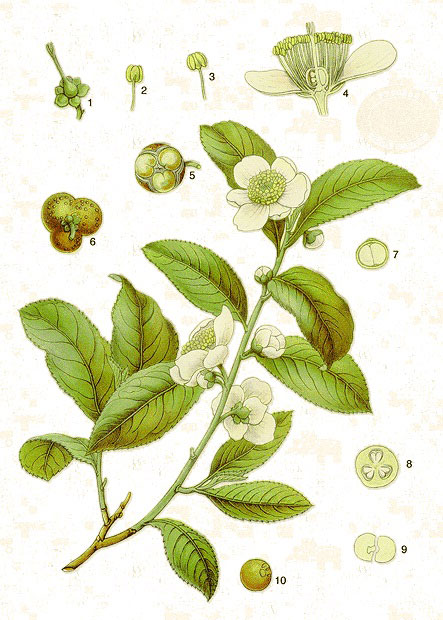Tea (Camellia sinensis) is a perennial evergreen shrub with a tap root system. Leaves are regular, short-petioled, leathery, shiny, oblong-elliptic, sharply toothed along the edge, up to 7 cm long and 4 cm wide, dark green above and light green below.
Flowers are solitary or 2-4 together, located in leaf axils on pedicels, white with a yellowish-pink tinge, up to 5 cm in diameter, with a pleasant odor.
Fruits are three or four nested woody cracking bolls. Seeds are rounded, dark brown, slightly shiny, up to 13 mm in diameter.
Figure designations:
- Pistil and calyx;
- Stamen (back view);
- Stamen (front view);
- Flower (longitudinal section);
- Fruit (upper part);
- Fruit (lower part);
- Seed (cross section);
- Ovary (transverse section);
- The core of the fruit (embryo);
- Seed.
Tea is planted by cuttings (less often one- to two-year-old seedlings). In especially favorable conditions, tea can be grown even from seeds, planting them 4-5 cm deep and watering them abundantly.
The first crop of leaves is harvested 4-5 years after planting. As a rule, tea bushes are actively pruned (shaping), preventing them from growing tall and stimulating the growth of a large number of side shoots.
A tea plantation usually consists of rows of tea bushes 1-1.5 m high with aisles between them also 1-1.5 m wide.
The greatest mass of leaves grows on tea up to 50-60 years, although tea trees (in Assam) give an excellent yield up to 90-100 years.
In favorable conditions tea grows very vigorously (up to 100 cm per year!), but it is difficult to observe these conditions.
The most important conditions for tea growth include:
- Warm summer and fall (average daily temperature not lower than 20°C) is the most important condition for normal tea growth. At the same time cold winter (the average daily winter temperature is necessarily below 10°C warm and up to -3°C).
- Long daylight hours and sufficient sunshine. On the length of the daylight hours and the abundance of sunlight directly depends on the concentration of, for example, aromatic substances in the tea leaf. If there is a lack of light and sunshine, the flavor of the tea becomes grassy, the tea becomes coarse, not aromatic.
- Moist soil, but well drained, there should be no stagnant water. The soil should be quite loose, light and yet slightly acidic. Very often tea plantations are located “stepped” on mountain slopes (terraces), which allows for optimal drainage of the soil.

